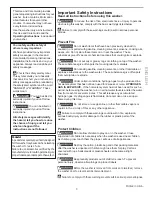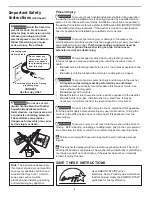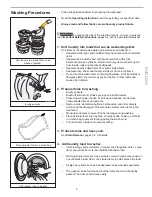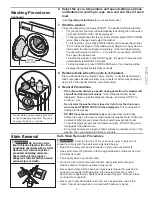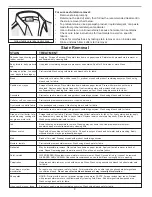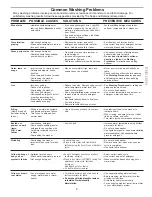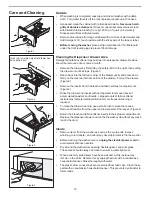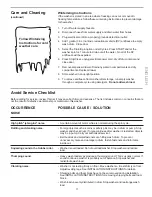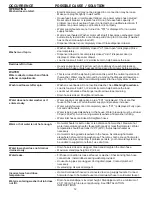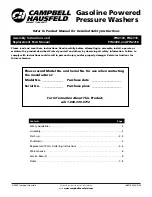
7
ENGLISH
Washing Procedures
(continued)
6. Select the cycle, temperature and speed settings options
and features according to type, size, and soil level of each
load.
(See Operating Instructions for your specific model.)
7. Start the washer.
Close the washer door and press START. The washer will fill and tumble.
•
For your safety, the door will automatically lock during the entire wash
cycle and "DOOR LOCK" will be displayed.
•
To change selections after the cycle has started, press STOP/CLEAR
twice. Make changes and restart the washer.
•
To interrupt the cycle, press STOP/CLEAR once to pause the washer.
"PAU" will be displayed. If the load was tumbling when the cycle was
interrupted, the door will open immediately. If the load was spinning,
the door will remain locked for 1 - 2 minutes for your safety. DO NOT
force open the locked door.
•
To restart the washer, press START again. (However, the washer will
automatically restart after 5 minutes.
•
To stop the washer, press STOP/CLEAR twice. Two dashes will be
displayed for approximately thirty seconds.
8. Remove items when the cycle is completed.
Place washed items in automatic dryer, line dry, or dry flat as directed by
fabric care label. Excess wrinkling, color transfer or odors may develop in
items left in the washer after the cycle has ended.
9. General Precautions
• If the dispenser drawer is opened during operation, the washer will
shut off and the door will unlock. "d:do" (dispenser door) will be
displayed. Slowly close the dispenser drawer, and press START to
continue cycle.
• Do not slam the washer door closed or try to force the door open
when locked ("DOOR LOCK" will be displayed). This could result in
damage to the washer.
• DO NOT leave the washer door open. An open door could entice
children to hang on the door or crawl inside the washer. Note: If there are
no small children present, leave the door ajar to prevent odor build.
• To avoid damaging the washer and personal injury, DO NOT hang on or
lean against the washer door.
• Do not place detergent, bleach or fabric softener containers on top of the
washer. They can damage the finish or controls.
Safe Stain Removal Procedures
To reduce the risk of fire or serious injury to persons or
property, comply with the basic warnings listed below:
• Read and comply with all instructions on stain removal products.
• Keep stain removal products in their original labeled containers and out
of children's reach.
• Thoroughly wash any utensil used.
• Do not combine stain removal products, especially ammonia and
chlorine bleach. Dangerous fumes may result.
• Never wash items which have been previously cleaned in, washed in,
soaked in or spotted with gasoline, dry cleaning solvents or other
flammable or explosive substances because they give off vapors that
could ignite or explode.
• Never use highly flammable solvents, such as gasoline, inside the
home. Vapors can explode on contact with flames or sparks.
Stain Removal
Do not use or mix
liquid chlorine bleach with other
household chemicals such as toilet
cleaners, rust removers, acid or
products containing ammonia.
These mixtures can produce
dangerous fumes which can cause
serious injury or death.
Do not store or place laundry products
on top of washer at any time. They can
damage the finish or controls.


